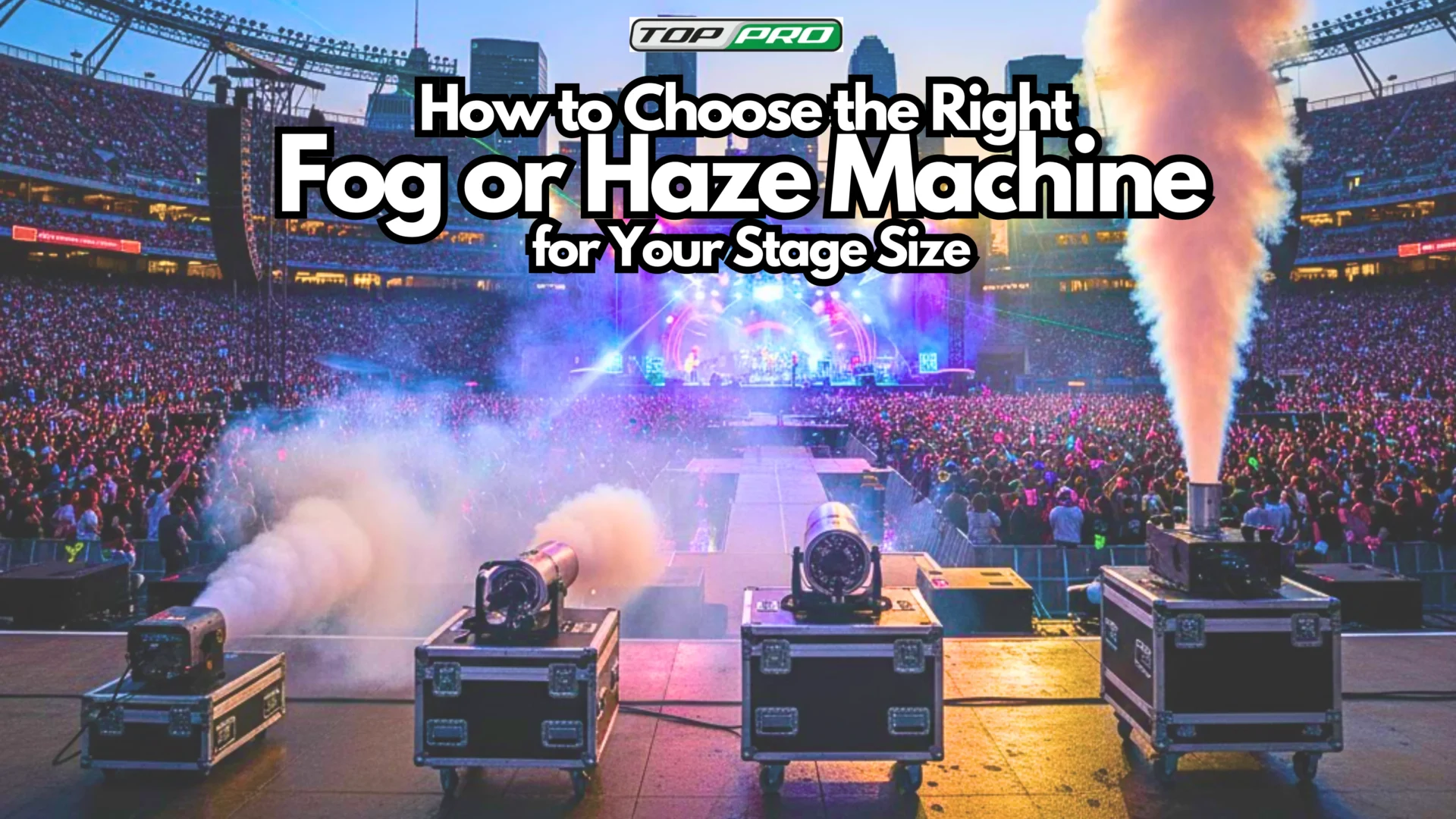How to Choose the Right Fog or Haze Machine for Your Stage Size

Fog and haze are the secret ingredients that make lighting pop. They turn invisible beams into bold, three-dimensional columns and give your stage a sense of depth and motion that can’t be achieved with lights alone. Whether you’re setting up for a worship concert, a theater production, or a touring EDM act, choosing the right atmospheric machine for your space is essential.
This guide walks you through how fog and haze machines work, what makes them different, and how to match the right model to your venue size, output needs, and power availability. We’ll also cover fluid types, warm-up times, DMX control, and maintenance so you can buy once and use confidently for years.
Why Fog and Haze Matter in Stage Lighting
Lighting fixtures rely on atmospheric particles to reveal their beams. Without them, even the most powerful moving heads just illuminate objects onstage — you’ll never see those gorgeous midair shafts that make lighting dynamic.
- Fog creates thick clouds or bursts that emphasize punchy beam effects.
- Haze produces a fine, even mist that reveals beams continuously without obscuring performers.
Pro Tip: If you’ve ever wondered why a professional concert looks “bigger” than a club show using the same fixtures, the answer is often haze quality.
Fog vs. Haze: What’s the Difference?
While both fill the air with particles, they do so in very different ways.
| Feature | Fog Machine | Haze Machine |
| Particle Size | Larger, visible clouds | Microscopic, evenly dispersed mist |
| Visual Effect | Bursty, dramatic plumes | Smooth, ambient air fill |
| Best For | Special effects, moments, accents | Consistent beam visibility |
| Fluid Type | Glycol-based fog fluid | Water or oil-based haze fluid |
| Duration | Short bursts (dissipate faster) | Long-lasting atmosphere |
| Typical Warm-up | 3–8 minutes | 1–3 minutes or continuous |
Heads-Up: Fog and haze machines use different fluids — never mix them. Doing so can damage the heater core or pump.
Understanding Stage Size and Air Volume
When choosing a machine, the most important metric isn’t wattage — it’s output relative to the space volume. A 700W fogger that fills a 500-square-foot club won’t cut it for a 3,000-seat theater.
Step 1: Estimate Your Stage Volume
- Measure width × depth × average ceiling height.
Example: 40ft × 30ft × 20ft = 24,000 cubic feet. - Add an audience area if you want the effect to reach beyond the stage.
Step 2: Match to Output Range
| Stage Type | Approx. Volume | Recommended Machine Power | Example Use |
| Small club / DJ booth | <5,000 cu. Ft. | 400–700W fogger or compact hazer | Local bar, mobile DJ |
| Medium stage/house of worship | 5,000–20,000 cu. ft. | 1,000–1,500W fogger or mid-range hazer | Bands, small theaters |
| Large theater/event hall | 20,000–40,000 cu. ft. | 1,500–2,500W fogger or pro hazer | Touring rigs, auditoriums |
| Arena / outdoor stage | 40,000+ cu. Ft. | Multiple 2,000W foggers or industrial hazers | Festivals, stadiums |
Pro Tip: When in doubt, go one size up. You can always run a stronger machine at a lower duty cycle, but an underpowered one will struggle to fill the air evenly.
Key Types of Machines
1. Fog Machines (Standard & High-Output)
These use a heated core to vaporize fog fluid. The vapor exits as a thick plume that dissipates in 30 seconds to a few minutes.
- Standard Foggers (400–1000W): Portable, suitable for DJs or small rooms.
- High-Output Models (1500–3000W): Fast warm-up, sustained output for large venues.
- CO₂ Foggers / Cryo Jets: Utilize liquid CO₂ for instant cold bursts without residue, making them ideal for concerts or clubs.
Pros: Dramatic, attention-grabbing bursts.
Cons: Can obscure vision if overused; needs venting and warm-up time.
2. Haze Machines
Hazers generate a fine, even mist that hangs for hours. They’re perfect for maintaining consistent beam visibility.
- Oil-Based Hazers: Long-lasting haze, quiet operation, but require ventilation and cleaning.
- Water-Based Hazers: Faster dispersion, safer for sensitive gear and lungs, ideal for indoor use.
Pros: Subtle, professional look; minimal distraction.
Cons: More expensive; requires regular maintenance for consistent output.
3. Fazers (Hybrid Units)
Fazers combine fog and haze functions — heating fog fluid but pushing it out continuously using fans. They offer a balance between the two effects.
Pros: Good all-rounder for mixed-use stages.
Cons: Not as smooth as true hazers or as thick as high-output foggers.
Fluid Types and Safety
| Fluid Type | Used In | Residue | Safe For | Typical Use |
| Glycol-based fog | Fog / fazer | Light film | Stage, open spaces | Burst effects |
| Glycerin-based fog | Fog | Minimal | Theatrical use | Dense clouds |
| Oil-based haze | Pro hazers | Slight residue | Large ventilated venues | Long-lasting haze |
| Water-based haze | Compact hazers | Clean | Indoors, sensitive gear | Subtle fill |
Heads-Up: Always use manufacturer-approved fluid. Off-brand fluids may clog heater elements or cause uneven particle size, thereby shortening the machine’s lifespan.
Power, Control, and Connectivity
Fog and haze machines vary in their integration with your lighting rig.
Power
- Wattage affects heat-up time and maximum output.
- Current draw matters: a 1500W machine at 120V can draw over 12A — plan your circuits accordingly.
Control Options
- Manual trigger / remote: Simple on/off or burst control.
- Timer-based: Adjustable interval and duration for consistent fogging.
- DMX-controlled: Sync fog/haze with lighting cues or music tempo.
- Wireless control: Great for mobile rigs where cabling is impractical.
Pro Tip: DMX integration lets you fade haze in gradually before a show and pulse fog bursts perfectly in time with your light transitions.
Placement and Airflow Strategy
Placement determines how evenly fog or haze disperses.
- Avoid blowing directly on performers. Aim airflow above or behind.
- Use fans for even coverage, particularly in areas with haze.
- Angle the output upward to let the mist settle naturally.
- For foggers: Mount low for ground effects; mount high for full coverage.
Example Setup
For a 30-foot-wide stage:
- One hazer upstage center, 6–8 feet high.
- Two small fans at 45° angles for crossflow.
- Optional fogger downstage left for cue-based bursts.
Checklist:
- Place machines away from HVAC vents.
- Use directional fans for control.
- Preheat machines before soundcheck.
- Test with lighting looks to adjust output levels.
Maintenance and Longevity
Like any stage gear, fog and haze machines last longer with regular care.
Cleaning Routine
- Flush the system every 40 hours of use with distilled water or a cleaning solution.
- Run dry for a few seconds afterward to clear the line.
- Store upright and capped to prevent air bubbles in the pump.
Preventive Tips
- Avoid running a fogger dry — it burns out the heater block.
- Check hoses and fittings monthly.
- Replace clogged filters as needed.
Heads-Up: Oil-based hazers require more frequent filter changes. Keep spare filters and cleaning fluid in your road case.
Noise, Residue, and Health Considerations
- Noise: Water-based hazers and CO₂ foggers are the quietest. Standard foggers can hum during heating.
- Residue: Use water-based fluid when working around instruments, cameras, or projectors.
- Health & Safety: Always verify local safety codes and regulations. Both fog and haze are safe when used as directed; however, ventilation is crucial for extended shows.
Pro Tip: Some venues (especially theaters and churches) restrict oil-based haze due to HVAC buildup. Always check the house rules before show day.
Choosing by Venue Type
| Venue | Recommended Machine | Notes |
| Club or DJ Setup | Compact fogger or water-based hazer | Quick bursts; easy setup |
| Medium Theater / Church | Water-based hazer or fazer | Balanced atmosphere; clean operation |
| Outdoor Stage / Festival | Multiple high-output foggers + fans | Overcome wind dispersion |
| Touring Rig | DMX hazer + CO₂ fog jets | Versatile for different venues |
| Film / Video | Water-based hazer | Uniform haze, no spotting on lenses |
Matching Fog or Haze to Lighting Fixtures
- Beams and Spots: Love haze — shows sharp aerial lines.
- Wash Lights: Benefit from light fog for diffusion.
- Lasers: Require ultra-fine haze for maximum visibility without scatter.
- Strobes: Combine with bursts of fog for dramatic hits.
Example: A 1500W fogger can fill a club during a drop, while a hazer quietly runs to maintain the atmosphere between songs.
Environmental and Cost Factors
- Fluid consumption: Hazers use less fluid over time, while foggers consume more per effect.
- Power efficiency: Modern LED-heated units warm faster and consume less electricity.
- Portability: Look for integrated handles, flight case options, and lockable casters for touring rigs.
Cost Breakdown (Approx.)
| Machine Type | Entry-Level | Mid-Range | Pro / Touring |
| Fog Machine | $100–$250 | $300–$700 | $800+ |
| Haze Machine | $250–$600 | $700–$1,200 | $1,500+ |
| CO₂ Fog Jet | $600–$1,000 | $1,200–$2,000 | $2,500+ |
Troubleshooting Common Issues
| Problem | Likely Cause | Fix |
| Weak output | Clogged heater block | Run a cleaning cycle or a vinegar flush |
| Uneven haze | Fan placement or air vent interference | Reposition fans and block airflow |
| Leaking fluid | Loose hose or overfilled tank | Tighten fittings, check seals |
| No heat / no output | Blown fuse or burnt element | Replace fuse; service heater block |
Pro Tip: Label machines with the last cleaning date and type of fluid used — it saves headaches on tour.
Final Recommendation
The best fog or haze machine isn’t just the most powerful one — it’s the one sized and tuned for your environment. Here’s a quick rule of thumb:
- Small spaces (clubs, rehearsal rooms): Compact fogger or fazer.
- Mid-size stages (churches, theaters): Quiet, water-based hazer.
- Significant events (arenas, festivals): Multiple high-output foggers or pro hazers with fan assist.
Plan your power, match your fluid, and keep your machines clean — then you’ll get professional, consistent results every night.
Ready to outfit your stage? Explore fog and haze machines tailored to your venue size, or consult with a stage specialist to design a comprehensive atmospheric rig.








